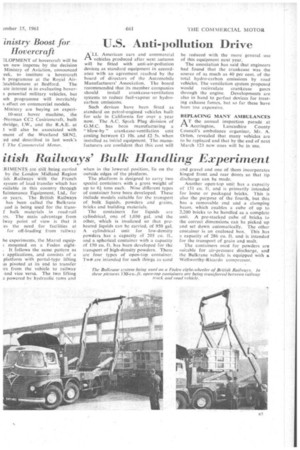itish Railways' Bulk Handling Experiment
Page 39

If you've noticed an error in this article please click here to report it so we can fix it.
:RIMENTS are still being carried by the London Midland Region :ish. Railways With the French system of load transfer which has vailable in this country through faintenance Equipment, Ltd„ for io years. The British Railways has been called the Bulkrane and is being used for the transf bulk materials in road-rail !rs. The main advantage from !way point of view is that it es the need for facilities at for off-loading from railway he experiments, the Marrel equip; mounted on a Foden eight. It follows the same pattern as applications, and consists of a platform with portal-type lifting as pivoted at its end to transfer :rs from the vehicle to railway and vice versa. The two lifting e powered by hydraulic rams and when in the lowered position, lie on the outside edges of the platform.
The platform is designed to carry two special containers with a gross weight of up to 61 tons each. Nine different types of container have been developed. These include models suitable for the transport of bulk liquids, powders and grains, bricks and building materials.
The containers for liquids are cylindrical, one of 1,030 gal, and the other, which is insulated so that preheated liquids can be carried, of 950 gal. A cylindrical unit for low-density powders has a capacity a 205 cu. ft., and a spherical container with a capacity of 150 Cu. ft. has been developed for the transport of high-density powders. There arc four types of open-top. container. Twts# are intended for such things as sand and gravel and one of them incorporates hinged front and rear doors so that tip discharge can be made.
Another open-top unit has a capacity of 151 cu, ft. and is primarily intended for loose or packaged bricks. This is also the purpose of the fourth, but this has a removable end and a clamping beam, which enables a cube of up to 2,200 bricks to be handled as a complete unit. A pre-stacked cube of bricks to the correct dimensions can be picked up and set down automatically. The other container is an enclosed box. This has a capacity of 286 Cu. ft. and is intended for the transport of grain and malt.
The containers used for powders are suitable for air-pressure discharge, and the Bulkrane vehicle is equipped with a Wel lworthy-R icardo corn pressor.




















































































































